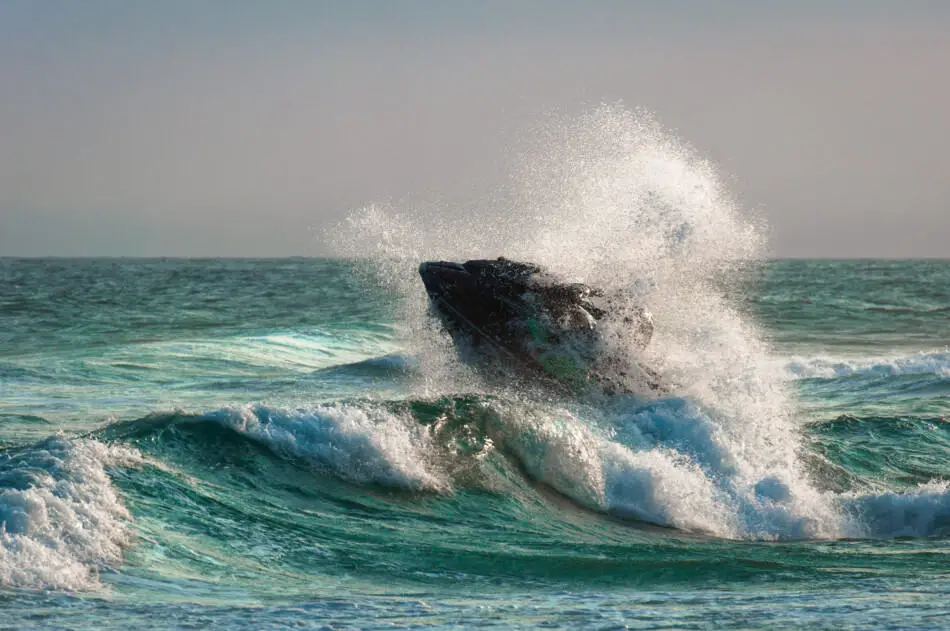
Riding a jet ski is one of the most enjoyable ways to spend your time on the water. Taking your jet ski into coastal and ocean waters is an entirely different game than just zipping around in a river or lake setting. Here are some tips for you to make sure you are operating your personal watercraft safely and enjoyably on the open ocean.
Jet Ski Ocean Riding Tips:
- Know the applicable laws for legal jet ski operations in your area.
- Be of an appropriate experience level for the location.
- Follow proper jet ski and maritime etiquette.
- Keep your safety equipment close at hand.
- Know how to read the wind and the water.
- Know where you are, and where you’re going.
While these might all seem like common sense, they can be more involved than some people realize. We are going to take a look at each one of these six tips, and how each one helps keep you safe on the water. The best day on the water always ends with making it home safely, and these tips will help you do just that.
Know Your State And, If Applicable, Maritime Laws
Whether you are jet skiing in California, Florida, Hawaii, or Alabama, each state has different laws regarding who can ride a jet ski in the ocean as well as specific safety laws.
In California, for example, a personal floatation device, such as a life jacket or life vest, must be worn at all times. They also have a minimum age for who can operate a jet ski. Boaters between the ages of 12 and 15 must be supervised by an adult if they will be operating anything with power beyond 15 horsepower. This law changes wildly on the east coast in Florida where, if you are 30 or older, you can operate a boat or jet ski without any training or licensing at all.
One of the most common causes of accidents in any setting is negligence, and most if not all states have prohibitions on operating jet skis or watercraft of any sort in a negligent manner. Negligence not only applies to knowing and understanding the rules for safe operation, but it extends to operating the crafts under the influence. Operating a jet ski or any other boat in a manner that endangers anyone else is negligent.
Jet Ski Ocean Riding Experience
When it comes to riding a jet ski, not everyone is ready to hit the waves of the ocean. Even if you have spent countless hours on a jet ski zooming around on your local lakes and rivers, there are things about boating and swimming in the ocean that are vastly different than the water that you are familiar with.
One requirement for jet skiing on the ocean is that you are a strong swimmer. Ocean jet skiing is not an activity that is recommended for beginners as the ocean is not as forgiving as lakes and rivers. The ocean is powerful and things can change with little to no warning. If you do fall off of your jet ski in the ocean, try to remain calm as panicking will only make the situation worse.
For those that are at the beginner to intermediate level, a ride close to shore with calm waves would be a great way to test the waters. If you are an advanced rider, then you would likely be comfortable with deep-sea and aggressive waves.
Keep in mind, that even the most experienced and well-seasoned jet ski operators can make mistakes or be caught off-guard by a surprise turn in the weather, and can suddenly be in a situation that is turning bad. Always exercise caution, no matter your experience level, and only go boating when conditions are good and the NOAA expects no severe weather in the immediate forecast.
Practice Proper Etiquette While Jet Skiing
One of the things to keep in mind when out on the water is that you are probably not the only one out enjoying the surf. Even if you do not see anyone else in the immediate area, always act as if there are several other people out with you. It is crucial that you always keep both your safety and the safety of others in mind to keep the experience fun for everyone.
When riding over crests of high waves, you may not be able to see other boaters, swimmers, or surfers, always prepare for someone to be on the other side.
To stay safe and clear-minded, avoid intoxicating substances before taking your ski out on the water. Keep an eye out for other jet skiers as well as boaters and water skiers. If you notice that any of the others are driving recklessly, try to steer clear and avoid them. Also, keep in mind that it takes up to 300 feet for a jet ski to come to a complete stop, so be sure not to get too close to other watercraft.
While it also falls under the heading of navigation, it is worth mentioning here as well, to pass buoys on the proper side for your direction of travel, just like driving on a road. If another vessel is in the lane as well, your poor etiquette can cause them to take emergency maneuvers, exacerbating an already dangerous situation.
Always Keep Proper Safety Equipment On Board your Jet Ski
The most obvious item here is your life jacket. When you are on a jet ski or other personal watercraft you are required to wear a personal flotation device or a life jacket. If you are operating a jet ski with multiple seats and you have passengers on board, each of them must also have and wear their personal floatation device. Other safety equipment that is good to have on hand is a key float, for the jet ski keys and other keys you may need. This should be a high visibility color like orange or chartreuse.
Often attached to the keys your or vest should also be an overboard switch or a kill switch. This clips to the ignition and only allows the jet ski to operate if it is in place. If you should happen to fall off the jet ski or go overboard for any reason, the cable pulls the clip off of the ignition, and the jet ski engine turns off. This is a vital piece of equipment that can save your life and the life of other boaters or swimmers if you fall off the jet ski or otherwise lose control of it.
Another often overlooked piece of safety equipment is the helmet. This is often only needed for beginners and for experienced operators who engage in tricks or stunts. The beginner or novice will find the helmet useful during their first few times falling off. If not used to the operation, the novice may hit their head while falling off, suffering any number of injuries and potentially becoming unconscious in the water. Advanced riders should also use them, as they tend to be more adventurous in their operation of the jet ski, often attempting to perform tricks or stunts.
Reading the Wind and Water on your Jet Ski
This tip, while important, is not something that can generally be learned by reading or researching, it often has to be experienced. As the wind on open water increases, it drags surface water along with it, creating surface currents, these can be different from deep water currents, but they will affect your jet ski much more significantly.
The wind will not only be able to create surface currents, but it will also create waves both small and large. Often wind gusts are not the warning of incoming dangerous weather, but steadily increasing wind speeds. If you are on the open water and the breeze seems to be getting stronger, but it is remaining steady, then you probably have a low-pressure system moving in which can mean dangerous conditions. These conditions can include large waves, often known as “whitecaps” as well as storm swells.
Know How To Safely Navigate On Open Water
One of the most important things to know before you head out on the water is how to not get lost. When you are close to shore, you can see the land but if you stray too far without a plan in mind, it’s easy to lose track of where you came from and where you are going. One thing you definitely do not want to happen is run out of gas, only to realize you have no idea where you are.
When riding around on open water, you can get lost really easily. Compasses are a great tool to keep with you. They work based on the Earth’s magnetic poles, so they are still accurate when out at sea. Most jet skis are limited on storage space so having a tool on hand that takes up minimal space is a smart move.
